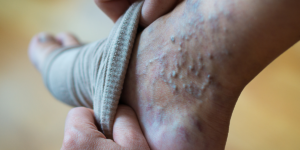Deep vein thrombosis (DVT) is a potentially life-threatening condition that occurs when a blood clot forms in one or more of the deep veins in the body, often in the legs. While it may seem like a relatively rare condition, DVT affects a significant number of individuals globally, and if left untreated, it can have severe consequences. In this article, we will delve into the threats posed by DVT, its causes, risk factors, symptoms, preventive measures, and available treatments.
One of the first questions that arise when exploring the topic of DVT is, why does it occur? Essentially, deep vein thrombosis forms when something disrupts the blood flow in the veins, causing blood to pool and clot. Numerous factors can contribute to this disruption, including injury to the veins, certain medical conditions, prolonged immobility, or a hypercoagulable state, where the blood is more prone to clotting.
Risk Factors for DVT
While DVT can affect anyone, certain factors increase the likelihood of developing this condition. It is essential to be aware of these risk factors to take appropriate measures for prevention. Some common risk factors include obesity, smoking, advanced age, family history of blood clotting disorders, pregnancy, hormone replacement therapy, birth control pills, and certain medical conditions such as cancer and heart disease.
Recognizing the Symptoms
The symptoms of DVT can vary from mild to severe, and in some cases, they may be absent. However, it is crucial to be vigilant and recognize any warning signs, as early detection is vital for effective treatment. Common symptoms of DVT include pain or tenderness in the affected leg, swelling, warm skin, redness, and visible veins. If you experience any of these symptoms, it is crucial to seek medical attention promptly.
Preventing Deep Vein Thrombosis
Prevention is key when it comes to DVT, especially for individuals with multiple risk factors. There are several measures one can take to reduce the risk of developing a blood clot. Staying active and regular exercise can help promote healthy blood flow and prevent blood pooling. If you are at high risk, you might consider using compression stockings to improve circulation in the legs. Additionally, avoid prolonged periods of immobility, such as sitting or standing for long periods, and make sure to stay well-hydrated.
Treatment Options
If diagnosed with deep vein thrombosis, there are several treatment options available. The primary goal of treatment is to prevent the clot from growing larger, breaking off, or causing further complications such as a pulmonary embolism. Depending on the severity and acuity of the clot and the patient’s overall health, the doctor may recommend blood-thinning medication, compression therapy, or, in some cases, a procedure to remove the clot. It is crucial to follow the prescribed treatment plan and closely monitor any changes in symptoms.
Seeking Medical Help
If you suspect you have deep vein thrombosis or are at risk, it is essential to seek medical help promptly. A healthcare professional can perform various diagnostic tests, such as ultrasound or blood tests, to determine if there is a blood clot present. They will also provide guidance on preventive measures and recommend appropriate treatment options, if necessary.
Conclusion
Deep vein thrombosis is a serious condition that can have severe consequences if not recognized and treated promptly. Understanding the threats posed by DVT, its risk factors, symptoms, and preventive measures are crucial for staying informed and taking appropriate action. If you want to learn more about deep vein thrombosis and how to prevent it, reach out to VidaVascular for expert advice and resources. Take control of your health today!





